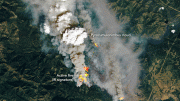
University of Arizona researchers have shown that human activities significantly affect Earth’s deep subsurface by altering fluid movements and impacting microbial ecosystems, underscoring the need for responsible management and further research in these deep environments to aid in climate change mitigation.
The effects of human activities like greenhouse gas emissions and deforestation on the surface of Earth are well-documented. Recently, hydrology researchers at the University of Arizona have explored the influence of humans on the deep subsurface of Earth, which extends from hundreds of meters to several kilometers below the surface.
“We looked at how the rates of fluid production with oil and gas compare to natural background circulation of water and showed how humans have made a big impact on the circulation of fluids in the subsurface,” said Jennifer McIntosh, a professor in the UArizona Department of Hydrology and Atmospheric Sciences and senior author of a paper in the journal Earth’s Future detailing the findings.
“The deep subsurface is out of sight and out of mind for most people, and we thought it was important to provide some context to these proposed activities, especially when it comes to our environmental impacts,” said lead study author Grant Ferguson, an adjunct professor in the UArizona Department of Hydrology and Atmospheric Sciences and a professor in the University of Saskatchewan’s School of Environment and Sustainability.
Future Projections and Collaborative Research
In the future, these human-induced fluid fluxes are projected to increase with strategies that are proposed as solutions for climate change, according to the study. Such strategies include: geologic carbon sequestration, which is capturing and storing atmospheric carbon dioxide in underground porous rocks; geothermal energy production, which involves circulating water through hot rocks for generating electricity; and lithium extraction from underground mineral-rich brine for powering electric vehicles. The study was done in collaboration with researchers from the University of Saskatchewan in Canada, Harvard University, Northwestern University, the Korea Institute of Geosciences and Mineral Resources, and Linnaeus University in Sweden.
“Responsible management of the subsurface is central to any hope for a green transition, sustainable future, and keeping warming below a few degrees,” said Peter Reiners, a professor in the UArizona Department of Geosciences and a co-author of the study.
Human Activities and Subsurface Water Cycle
With oil and natural gas production, there is always some amount of water, typically saline, that comes from the deep subsurface, McIntosh said. The underground water is often millions of years old and acquires its salinity either from evaporation of ancient seawater or from reaction with rocks and minerals. For more efficient oil recovery, more water from near-surface sources is added to the salt water to make up for the amount of oil removed and to maintain reservoir pressures. The blended saline water then gets reinjected into the subsurface. This becomes a cycle of producing fluid and reinjecting it to the deep subsurface.
The same process happens in lithium extraction, geothermal energy production, and geologic carbon sequestration, the operations of which involve leftover saline water from the underground that is reinjected.
“We show that the fluid injection rates or recharge rates from those oil and gas activities is greater than what naturally occurs,” McIntosh said.
Using existing data from various sources, including measurements of fluid movements related to oil and gas extraction and water injections for geothermal energy, the team found that the current fluid movement rates induced by human activities are higher compared to how fluids moved before human intervention.
As human activities like carbon capture and sequestration and lithium extraction ramp up, the researchers also predicted how these activities might be recorded in the geological record, which is the history of Earth as recorded in the rocks that make up its crust.
Impact on Microbial Life and Future Research Needs
Human activities have the potential to alter not just the deep subsurface fluids but also the microbes that live down there, McIntosh said. As fluids move around, microbial environments may be altered by changes in water chemistry or by bringing new microbial communities from Earth’s surface to the underground.
For example, with hydraulic fracturing, a technique that is used to break underground rocks with pressurized liquids for extracting oil and gas, a deep rock formation that previously didn’t have any detectable number of microbes might have a sudden bloom of microbial activity.
There remain a lot of unknowns about Earth’s deep subsurface and how it is impacted by human activities, and it’s important to continue working on those questions, McIntosh said.
“We need to use the deep subsurface as part of the solution for the climate crisis,” McIntosh said. “Yet, we know more about the surface of Mars than we do about water, rocks, and life deep beneath our feet.”
Reference: “Acceleration of Deep Subsurface Fluid Fluxes in the Anthropocene” by Grant Ferguson, Lydia R. Bailey, Ji-Hyun Kim, Magdalena R. Osburn, Peter W. Reiners, Henrik Drake, Bradley S. Stevenson and Jennifer C. McIntosh, 5 April 2024, Earth’s Future.
DOI: 10.1029/2024EF004496
The study was funded by the Natural Sciences and Engineering Research Council of Canada and the National Science Foundation.









Bringing climate change into this story is one of the reasons the public skepticism of the topic continues to grow. It’s quite a stretch to claim a link between climate change and a place where “we know more about the surface of Mars than we do about water, rocks, and life deep beneath our feet.”
“Acceleration of Deep Subsurface Fluid Fluxes in the ANTHROPOCENE”
Not only is the Anthropocene NOT an approved geologic subdivision of time, the proposal to adopt it was formally rejected recently by the committee appointed to study the proposal.
https://wattsupwiththat.com/2024/04/25/anthropocene-the-cockroach-of-the-geologic-time-scale/
When I read research by supposed experts who use unapproved terminology, I question their expertise. It seems to me that they either are not keeping up with events in their discipline, or they don’t care because their primary goal is to advance a political agenda. Either way, it should give others pause as to how reliable any of their claims are if they are using terminology that is not sanctioned, and they appear to have a bias. It used to be that the epitome of scientific endeavor was investigation by a “disinterested observer” and by inductive logic formed multiple working hypotheses to explain the observations. That is, one who who was objective and did not have a preconceived bias for a particular interpretation of the observations. Far too many self-proclaimed scientists today are working the system to get grants from political funding sources by pandering to the biases of those controlling the purse strings.
Unfortunately, here we go again,
eg, “Responsible management of the subsurface is central to any hope for a green transition, sustainable future, and keeping warming below a few degrees,”
For goodness sake please, please stop, amongst other overly undefined vague terms, stop using the term “green transition”.
What’s the proposed unsubsidised practical (“transitioned”) end point?
So what’s the “final solution”?
Back to Utopia by depopulating the planet and getting rid of all human activity?
Interim measures: Develop products to enable self-generation/repair so we no longer need manufacturing (another form of life perhaps!)?
Manufacture batteries out of batteries, run the whole planet on fabled “green only” electricity?
… lots of other useful research topics here, to hook onto “climate change” funding requests.
we are kicking the crap out of the earth….sucking all the oil and gas we can…gotta feed the 8-9 BILLION mouth breathers out there……the bill will come due but not for quite a while…..hold on!!!